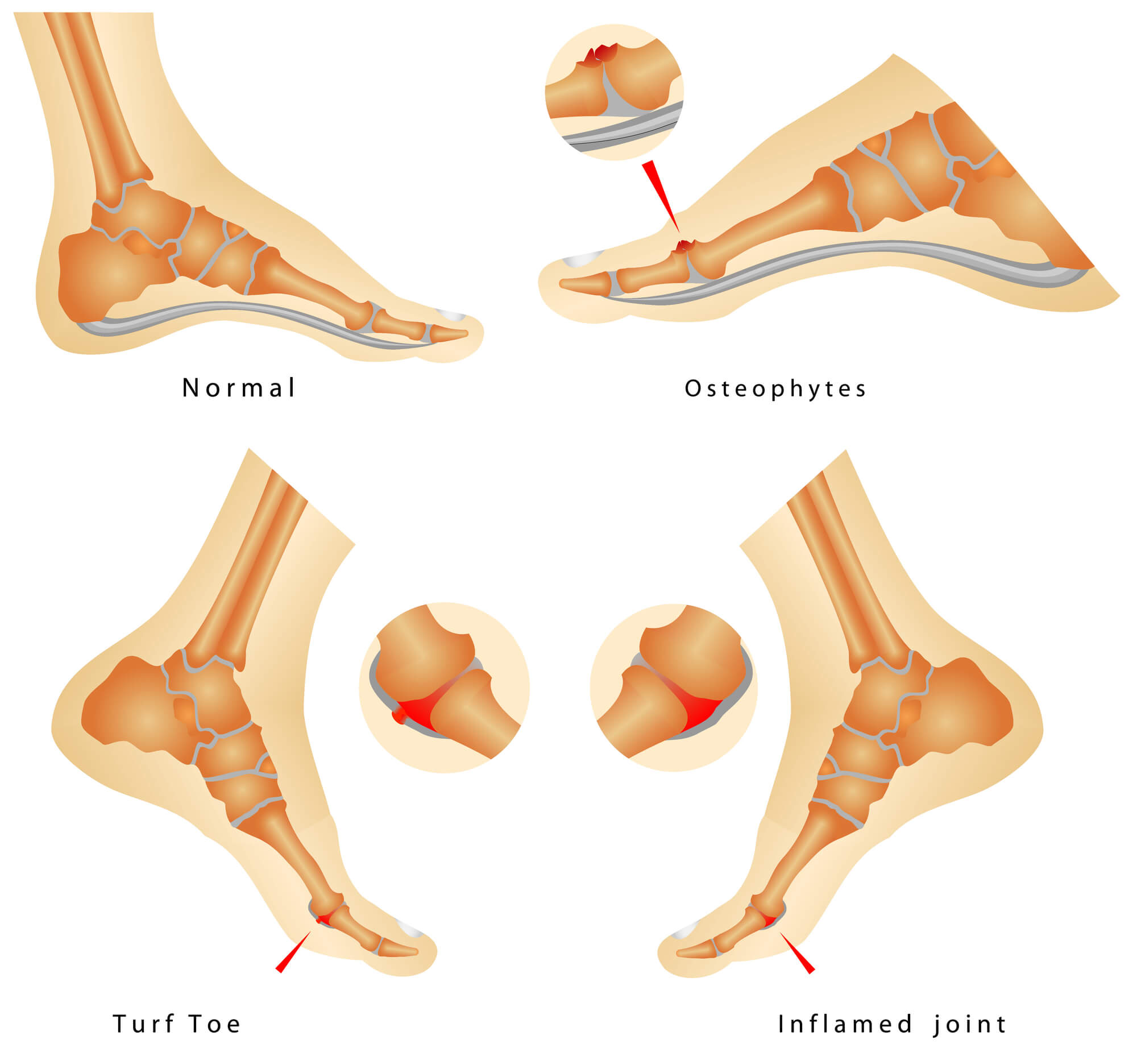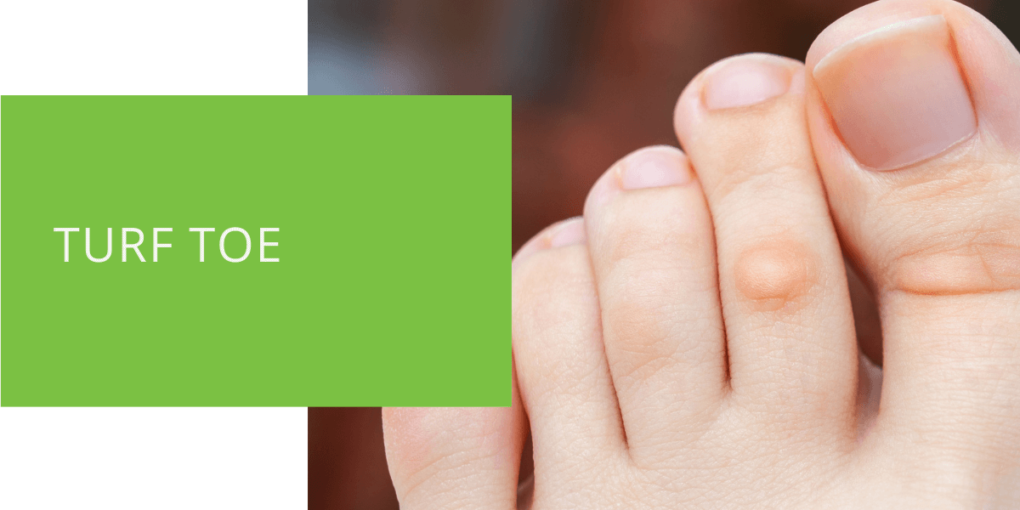Understanding Turf Toe
Turf toe is a common yet often underestimated condition in sports injuries, particularly among athletes who play on artificial turf. Whether you're a professional football player or a weekend warrior engaging in recreational activities, understanding turf toe is crucial for prompt diagnosis, effective treatment, and prevention of long-term complications.
Key Takeaways
- Turf toe is a common injury among athletes, characterized by pain and swelling at the base of the big toe, often caused by hyperextension during sports activities on artificial turf.
- Diagnosis involves a physical examination, imaging tests like X-rays and MRI, and assessment of symptoms to differentiate turf toe from other toe injuries.
- Treatment options range from conservative measures like rest, ice, and physical therapy to surgical intervention for more severe cases, focusing on promoting healing, restoring function, and preventing future occurrences.
What is a Turf Toe?
Turf toe is a term used to describe an injury to the ligaments around the big toe joint, typically caused by hyperextension of the toe. This injury often occurs when athletes play on artificial turf, which can be less forgiving than natural grass surfaces. The sudden, forceful bending of the big toe beyond its normal range of motion can lead to sprained ligaments or even ligament tears, resulting in pain, swelling, and limited mobility.
Symptoms of Turf Toe
Recognizing the symptoms of turf toe is essential for early intervention and optimal recovery. Common symptoms include:
- Pain at the base of the big toe: Patients may experience sharp or dull pain, especially during movement or weight-bearing activities.
- Swelling and tenderness: The affected area may appear swollen, and touching or applying pressure to the toe can elicit tenderness.
- Difficulty bending or straightening the toe: Reduced range of motion in the big toe joint is a hallmark of turf toe.
Understanding these symptoms can help individuals seek timely medical attention and avoid exacerbating the injury.
Causes of Turf Toe
Turf toe typically occurs when the big toe is forcibly bent upward beyond its normal range of motion. This can happen during various athletic maneuvers, such as pushing off to accelerate or abruptly stopping while running. Some common causes include:
- Playing on artificial turf: The firm, unforgiving surface of artificial turf can increase the risk of hyperextension injuries compared to natural grass.
- Repetitive stress: Athletes who engage in activities that require frequent pushing off or sudden changes in direction are more susceptible to turf toe injuries.
- Footwear: Improper footwear, such as cleats that don't provide adequate support, can contribute to the development of turf toe.
Understanding these underlying causes can help individuals take preventive measures to reduce their risk of injury.
Diagnosing Turf Toe
Diagnosing turf toe typically involves a comprehensive podiatrist or sports medicine specialist evaluation. This may include:
- Physical examination: The healthcare provider will assess the range of motion, stability, and tenderness of the big toe joint.
- Imaging tests: X-rays may be ordered to rule out fractures, while MRI or CT scans can provide detailed images of soft tissue structures, such as ligaments.
- Assessment of symptoms: Detailed history-taking and discussion of symptoms can help differentiate turf toe from other toe injuries or conditions.
Accurate diagnosis is crucial for developing an appropriate treatment plan and preventing potential complications.

Treating Turf Toe
Treatment for turf toe varies depending on the severity of the injury. In general, conservative measures are recommended initially and may include:
- Rest, ice, compression, elevation (RICE): Resting the affected foot, applying ice packs, compressing the area with a bandage, and elevating the foot can help reduce pain and swelling.
- Immobilization: In some cases, wearing a walking boot or using taping techniques to stabilize the toe may be necessary to promote healing.
- Pain management: Over-the-counter pain relievers or anti-inflammatory medications may be recommended to alleviate discomfort.
- Physical therapy: Gentle stretching and strengthening exercises can help restore mobility and function to the toe joint.
In more severe cases, such as grade 2 or grade 3 injuries, surgical intervention may be considered to repair damaged ligaments or stabilize the joint.
Recovery Time for Turf Toe
The recovery time for turf toe can vary depending on the severity of the injury and individual factors such as age and overall health. Mild cases may generally heal within a few weeks with conservative treatment, while more severe injuries may require several months of rehabilitation. Physical therapy plays a crucial role in recovery, helping patients regain strength, flexibility, and range of motion in the affected toe.
Grades of Turf Toe
Turf toe injuries are often classified into three grades based on their severity:
- Grade 1: Mild sprain with minimal ligament damage and relatively mild symptoms.
- Grade 2: Partial tearing of ligaments, resulting in moderate pain, swelling, and instability.
- Grade 3: Severe sprain with complete ligament rupture, causing significant pain, swelling, and loss of function.
Understanding the grade of turf toe injury is essential for determining the appropriate treatment approach and predicting the prognosis.
Preventing Turf Toe
Preventing turf toe involves several strategies to reduce the risk of hyperextension injuries to the big toe joint. Some preventive measures include:
- Proper footwear: Choosing footwear with adequate support and cushioning can help absorb shock and reduce the strain on the toe joint.
- Orthotic inserts: Custom orthotic inserts or shoe inserts can provide additional support and stability, especially for individuals with high arches or flat feet.
- Technique modification: Athletes should consider their movement patterns and technique to avoid excessive stress on the big toe joint.
- Gradual progression: Increasing the intensity and duration of athletic activities can help minimize the risk of overuse injuries, including turf toe.
By incorporating these preventive strategies into their training regimen, athletes can reduce their risk of sustaining turf toe and other common sports-related injuries.
Conclusion
Turf toe is a prevalent injury that can affect athletes of all levels, particularly those who play on artificial turf surfaces. Recognizing the symptoms, understanding the underlying causes, and seeking timely medical attention is crucial in effectively managing turf toe and preventing long-term complications. Whether you're experiencing toe symptoms or seeking guidance on injury prevention, our team at ePodiatrists is here to provide expert care and personalized treatment solutions. Don't let turf toe keep you sidelined – schedule an appointment with us today, take the first step toward recovery, and return to your favorite sports and activities.

